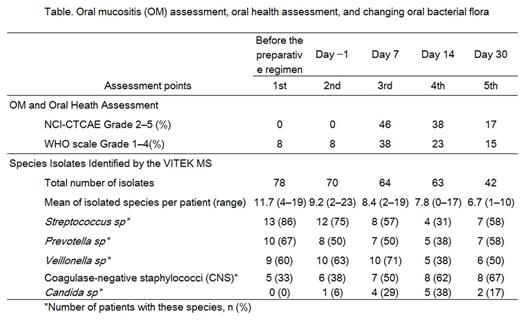Abstract
Introduction
Approximately 70%-90% patients receiving hematopoietic stem-cell transplantation (HSCT) have oral mucositis (OM). HSCT-induced OM is a major complication of preparative regimens. The oral cavity of healthy individuals harbor several bacterial species. For example, the cheek and tongue harbor a number of Streptococcus species, while the predominant genera in the saliva are Prevotella, Streptococcus, and Veillonella. The resident flora are considered to be deeply linked with OM because they prevent colonization by exogenous organisms having pathogenic potential for local and systemic infections. However, the precise bacterial substitution occurring in HSCT patients with OM remains unclear. Here, we prospectively examined oral bacterial flora changes using VITEK MSTM (SYSMEX bioMérieux Co., Ltd., Tokyo, Japan)-an automated mass spectrometry (MS) microbial-identification system using matrix assisted laser desorption ionization time-of-flight (MALDI-TOF) technology. It can detect about 650 bacterial and 105 fungal species. We aimed to determine whether oral microbial in HSCT can be detected by VITEK MSTM.
Patient and Methods
This prospective study included 16 patients (10 males, 6 females; median age 52 years) who underwent HSCT for hematological malignancies (auto-PBSCT = 3 patients, allo-PBSCT = 3 patients, CBT = 10 patients; preparative regimen: MAC = 11 patients, RIC = 2 patients, auto = 3 patients) in our hospital between December 2015 and July 2016. All were treated in reverse isolation in a laminar airflow-equipped room and received drugs to prevent bacterial, fungal, and herpes virus infection. We used VITEK MS for analyzing oral bacterial flora. OM was diagnosed according to NCICTCAE v4.0 and WHO scale, and oral health was assessed using the Revised Oral Assessment Guide (ROAG). Microbial samples were obtained using swabs from bilateral buccal mucosa, palate, and tongue. Samples were then incubated at 37‹C for 72-96 hours both aerobically and anaerobically. Finally, VITEK MS was used to identify bacterial species in samples. We evaluated the patients before initiating preparative regimen (1st), day −1 before HSCT (2nd), 7 days after HSCT (3rd), 14 days after HSCT (4th), and 30 days after HSCT (5th).
Results
The percentage of patients with high-grade OM (CTCAE Grade 2-5, and WHO Grade 1-4) increased in days 7-14 and decreased at day 30 (Table). Total bacterial species numbers gradually decreased from days -1 through to 30. Many Streptococcus sp could be detected at the 1st or 2nd time point, but these speciesgradually decreased and were replaced with coagulase-negative staphylococci (CNS; Staphylococcus epidermidis in 10 patients, S. haemolyticus in 5 patients, S. lentus in 3 patients, andS.warneri in 3 patients). Before HSCT, Prevotella sp and Veillonella sp in the oral flora were detected in 10 and 9 patients, respectively. However, by 14 days after HSCT, Prevotella sp and Veillonella sp were isolated less often than other points. Candida sp was detected only after the preparative regimen.
Discussion and Conclusion
This is the first prospective study to demonstrate microbial substitution in oral bacterial spices in HSCT patients using VITEK MS. VITEK MS allowed for the reliable identification of clinically relevant bacteria. We found that the oral bacterial species changed from Streptococcus sp, Prevotella sp, or Veillonella sp to CNS or Candida sp after HSCT. Our results suggest that oral microbial substitution possibly underlies high-grade OM after HSCT. We also suspect that microbial substitution is partly modified by antibiotics, considering that all study patients were treated with antimicrobial agents (including beta-lactam antibiotics). Indeed, the presence of many beta-lactam sensitive Streptococcus sp decreased, whereas that of beta-lactam resistant strains (CNS and Candida sp)increased. Finally, this study involved a small and heterogeneous patient population with varying characteristics. Therefore, our results require confirmation in a larger number of patients over a longer period.
Hironaka:MEXT Supported Program for the Strategic Research Foundation at Private Universities: Research Funding.
Author notes
Asterisk with author names denotes non-ASH members.


This feature is available to Subscribers Only
Sign In or Create an Account Close Modal